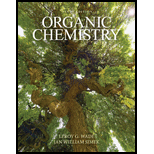
(a)
To determine: The accomplishment of given synthetic conversion.
Interpretation: The accomplishment of given synthetic conversion is to be stated.
Concept introduction: The metallic sodium is used for conversion of alcohols into sodium alkoxide. The further reaction of sodium alkoxide with an
(b)
To determine: The accomplishment of given synthetic conversion.
Interpretation: The accomplishment of given synthetic conversion is to be stated.
Concept introduction: Sodium hydroxide is used for the conversion of alkyl halide into primary alcohol. The conversion of a primary alcohol into
The Grignard reagent is prepared by reaction of an alkyl halide with metallic magnesium in the presence of THF (tetra hydro furan). The further reaction of prepared aldehyde with Grignard reagent in the presence of
(c)
To determine: The accomplishment of given synthetic conversion.
Interpretation: The accomplishment of given synthetic conversion is to be stated.
Concept introduction: The Grignard reagent is prepared by reaction of an alkyl halide with metallic magnesium in the presence of THF (tetra hydro furan). The further reaction of an aldehyde with Grignard reagent in the presence of
(d)
To determine: The accomplishment of given synthetic conversion.
Interpretation: The accomplishment of given synthetic conversion is to be stated.
Concept introduction: The conversion of a primary alcohol into aldehyde is done by PCC reagent. The further reaction of aldehyde with Grignard reagent in the presence of
Want to see the full answer?
Check out a sample textbook solution
Chapter 11 Solutions
Pearson eText Organic Chemistry -- Instant Access (Pearson+)
- Can I get help on drawing my arrowsarrow_forwardCan I get helpp drawing my arrowsarrow_forwardWhich of the m/z values corresponds to the base peak in the mass spectrum shown? 100 80 A. 45 B. 44 C. 29 D. 15 Intensity 20 0 10 20 30 40 B- m/z -8 50 E. 30 Which of the m/z values correspond to the molecular ion for the compound shown? A. 18 B. 82 OH C. 100 D. 102 E. 103arrow_forward
- Please explain how to calculate the pH.arrow_forwardI'm having trouble with converting lewis diagrams into VSEPR diagrams. I currently have this example of C2BrCl3 which I want to turn into a lewis structure, but I'm not sure what steps I need to do in order to do so. I have the table written down, however, there's two central atoms so what would I do? There seems to be 4 electron domains on the carbon atom and no lone pairs so it would seem like this shape would be tetrahedral. Here's what I have now. Thanks!arrow_forwardWe discussed the solid phase resin using in peptide synthesis. Provide a mechanism, for its formation. DRAW THE MECHANISM.arrow_forward
 Organic Chemistry: A Guided InquiryChemistryISBN:9780618974122Author:Andrei StraumanisPublisher:Cengage Learning
Organic Chemistry: A Guided InquiryChemistryISBN:9780618974122Author:Andrei StraumanisPublisher:Cengage Learning

